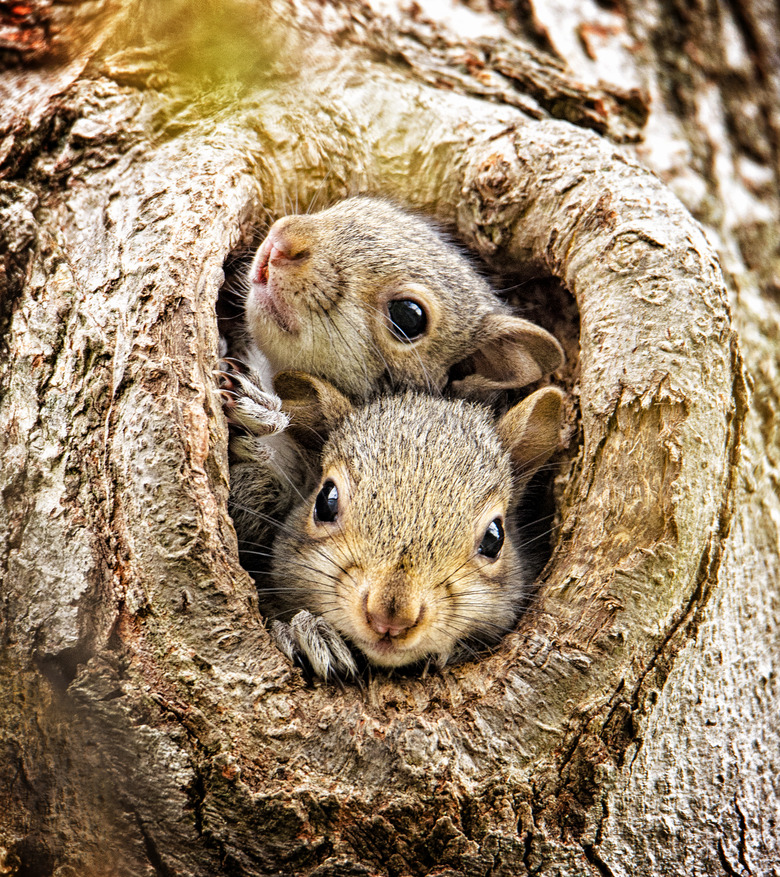How Long Do Squirrels Nurse Their Young?
There are more than 200 species of squirrels (family Sciuridae) around the world. The smallest squirrel species, like the African pygmy squirrel (Myosciurus pumilio) weigh only half a pound and measure five inches long. The black giant squirrel (Ratufa bicolour) is the largest species, weighing up to four pounds and growing up to 36 inches long. Squirrels nurse in similar ways regardless of species, and baby squirrels eat an omnivorous diet after weaning off their mothers' milk.
Squirrel Mating
Squirrel Mating
While female squirrels only mate two or three times a year, males can mate continuously. When trying to get the attention of a female, the male proceeds to slap trees with his paws and chatter loudly. After mating, the males leave the female alone to raise their babies, often called pups. Once the young have left the nest, the male may try to mate with the same female again.
Squirrel Breeding
Squirrel Breeding
After mating, squirrel gestation is usually around 35 to 45 days. Most squirrels birth between two and eight babies per litter. A mother squirrel can have several litters per year. The mother will build her nest in a burrow or high up in a tree, depending on whether she is a ground or tree-dwelling squirrel. When they are first born, baby squirrels are blind and entirely reliant on their mothers to survive.
Female squirrels are very protective of their young. If an unprotected nest of baby squirrels is found, they should be left alone. Mothers will leave the nest at times to eat, but they will not go too far. If she hears her babies being disturbed, she will run back to the nest.
In the wild, North American red squirrels (Tamiasciurus hudsonicus) sometimes adopt the orphaned babies of close relatives. Whether or not she adopts a relative's babies depends on how many of her own she has. Adopting other babies can put her own at risk as there are more mouths to feed. For example, if she only has two of her own, she may adopt nieces and nephews if they are orphaned, but if she has three, she may only adopt grandchildren or siblings that she is more closely related to.
Mothers Nursing Baby Squirrels
Mothers Nursing Baby Squirrels
Squirrels have up to ten mammary glands with parallel sets of nipples running down their chest. A lactating female is easily recognizable as her nipples elongate and she loses the hair around them. These body changes make it easier for her babies to latch onto a nipple when feeding. Squirrels feed their babies milk every two to four hours until they are weaned onto solid foods and are ready to leave the nest.
Once their eyes have opened and they are ready to start weaning to solid foods, they follow their mother around the nest site. If the population density in an area is low, the young females will build nests nearby to raise their young. If the population density is high, they will have to venture further once they leave their mother.
When Do Squirrels Leave the Nest?
When Do Squirrels Leave the Nest?
The time it takes for a baby squirrel to become independent varies between species. For example, North American gray squirrels (Sciurus carolinensis) open their eyes at around four weeks old and are ready to leave their mothers by the time they are ten weeks old. Grey squirrels typically have two litters per year.
Prevost's squirrel (Callosciurus prevostii), native to Southeast Asia, generally has three litters per year and the young are fully independent at six weeks old.
Nursing Orphaned Baby Squirrels
Nursing Orphaned Baby Squirrels
Baby squirrels are best left with their mothers, but those that end up being hand-fed in captivity should be fed warm puppy formula with a syringe. Drinking formula gives them the best nutrition possible next to drinking their mother's milk. Baby squirrels also need to have their genitals massaged several times a day to stimulate them to urinate and defecate, something their mother would normally do.
By the time they are two to three months old, they should be eating a mostly solid diet of fruit, vegetables, nuts and seeds. Weaning from milk to solids should be done over several weeks as their digestive system needs time to adapt to solid foods. A highly nutritious diet is vital for healthy growth and development.
References
- National Geographic: Squirrels
- Greater Good Magazine: The Kindness of Squirrels
- The Wildlife Center of Virginia: Baby Squirrels
- National Geographic: Viral Photo Sparks Unusual Discussion of Squirrel Anatomy
- Smithsonian's National Zoo: Prevost's Squirrel
- AAA Wildlife Control: Squirrel Facts & Information
Cite This Article
MLA
Jerrett, Adrianne. "How Long Do Squirrels Nurse Their Young?" sciencing.com, https://www.sciencing.com/long-do-squirrels-nurse-young-8733012/. 30 September 2021.
APA
Jerrett, Adrianne. (2021, September 30). How Long Do Squirrels Nurse Their Young?. sciencing.com. Retrieved from https://www.sciencing.com/long-do-squirrels-nurse-young-8733012/
Chicago
Jerrett, Adrianne. How Long Do Squirrels Nurse Their Young? last modified March 24, 2022. https://www.sciencing.com/long-do-squirrels-nurse-young-8733012/
